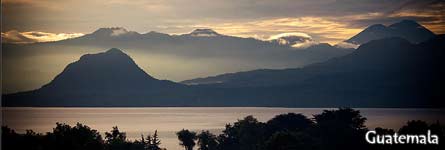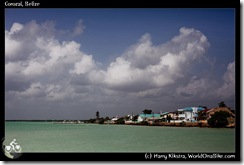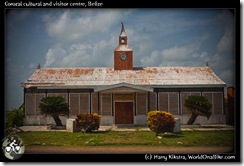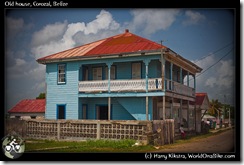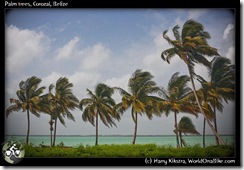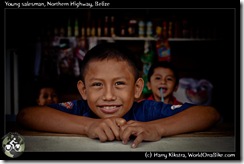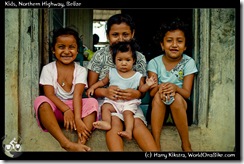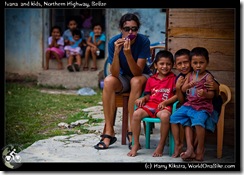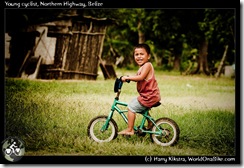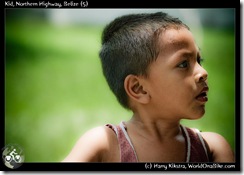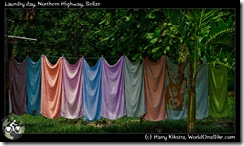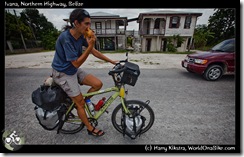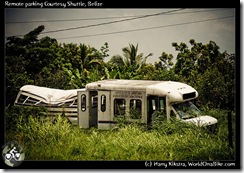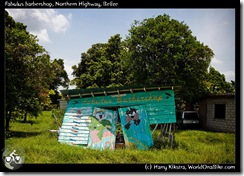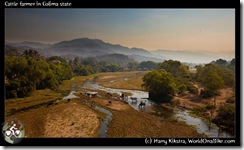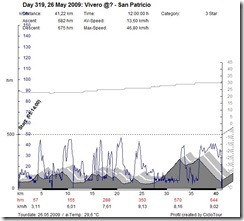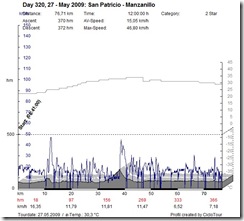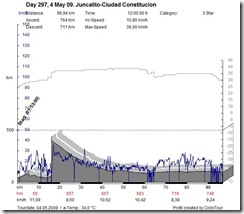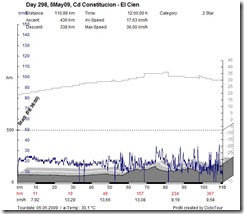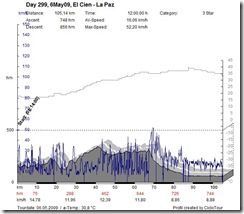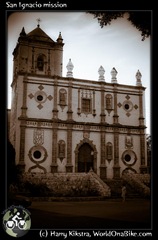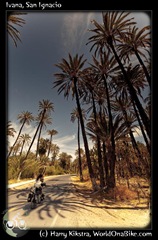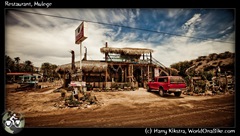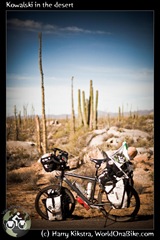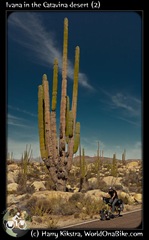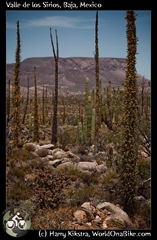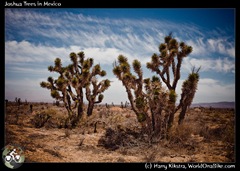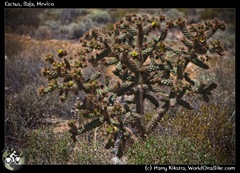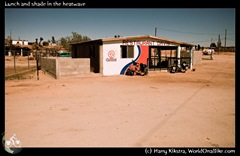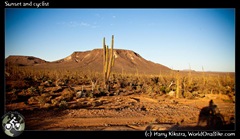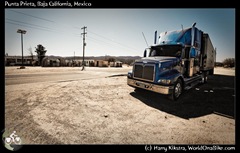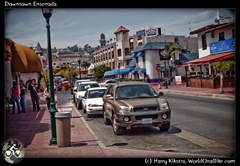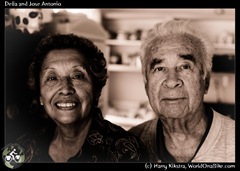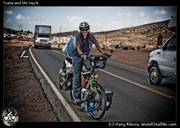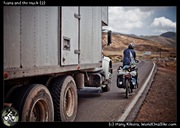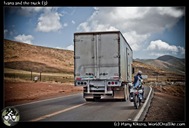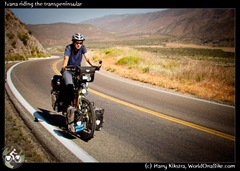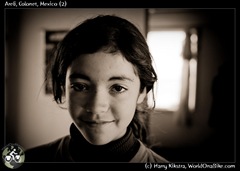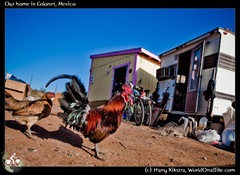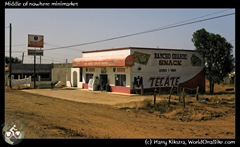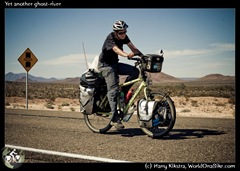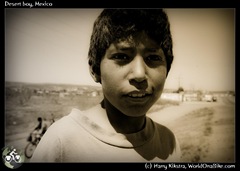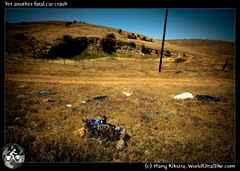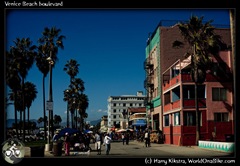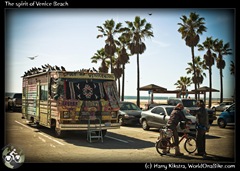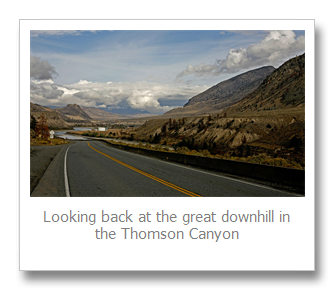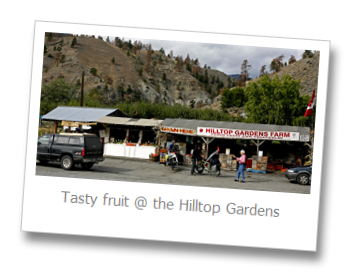Day 380-383, 26-29 July: The Northern Highway and shady Belize City, into Belize!
October 28, 2009 by Harry
Filed under Belize, Central America, Trip reports
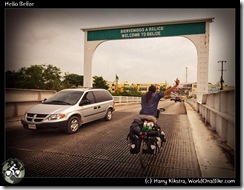 After crossing the bridge that separated Mexico from Belize, we still had to do some formalities. I could just ride my bike into the office and get a free stamp, valid for 4 weeks, but Ivana had to pay.
After crossing the bridge that separated Mexico from Belize, we still had to do some formalities. I could just ride my bike into the office and get a free stamp, valid for 4 weeks, but Ivana had to pay.
Sometimes being an Argentine helps dodging costs: for some unknown reason she does not have to pay for visa for for example turkey & India, whereas I do. But in order to enter Belize, she needed to pay B$100, 100 Belize Dollars, equalling USD $50! It must have something to do with the old ties to the Argentine archenemies, the Brits (Islas Malvinas, anyone?).
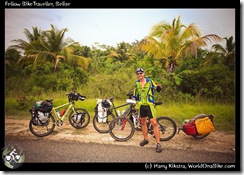 We also had to state where we wanted to exit Belize, which we had not expected. As there are only 3 options and we did not want to exit the way we just came in, we had to choose between the land border close to Tikal, Guatemala and the Southern sea-port of Punta Gorda. We opted for the latter and so the basics of our time and route through Belize were fixed more than we would have liked to: maximum 4 weeks, in through the North, out through the South.
We also had to state where we wanted to exit Belize, which we had not expected. As there are only 3 options and we did not want to exit the way we just came in, we had to choose between the land border close to Tikal, Guatemala and the Southern sea-port of Punta Gorda. We opted for the latter and so the basics of our time and route through Belize were fixed more than we would have liked to: maximum 4 weeks, in through the North, out through the South.
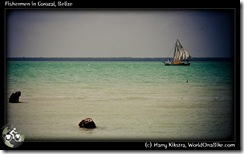 We continued on a flat road through muggy mosquito-filled fields and even met another cyclist headed North, who showed us his bike with mono-wheel trailer. he said it was very strong, but while demonstrating how to get on the bike, it came off, which did not seem too secure to us..
We continued on a flat road through muggy mosquito-filled fields and even met another cyclist headed North, who showed us his bike with mono-wheel trailer. he said it was very strong, but while demonstrating how to get on the bike, it came off, which did not seem too secure to us..
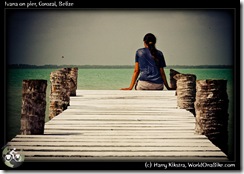 Some miles later, we rolled through neatly trimmed lawns –seems the Brits left another legacy here- topped with old and worn houses into the fisherman’s town of Corozal. We liked the relaxed and friendly place, enjoyed some nice hand-made ice-cream and went to look for a cheap place to stay.
Some miles later, we rolled through neatly trimmed lawns –seems the Brits left another legacy here- topped with old and worn houses into the fisherman’s town of Corozal. We liked the relaxed and friendly place, enjoyed some nice hand-made ice-cream and went to look for a cheap place to stay.
The cheapest rooms were in this non-touristic town where still more than B$25, which was more than our daily budget. We started to believe the scary stories of costly Belize that other travellers had told us.
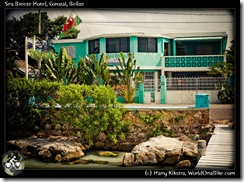 Finally we came upon a nice classic-looking hotel, named the sea-breeze hotel. We asked owner Gwynn if we could camp in his yard but he insisted we camp within the gate and under shelter of his sea-view bar instead. A while later he even offered us to stay for free in the spare room that was normally used by the cook, thanks Gwynn!
Finally we came upon a nice classic-looking hotel, named the sea-breeze hotel. We asked owner Gwynn if we could camp in his yard but he insisted we camp within the gate and under shelter of his sea-view bar instead. A while later he even offered us to stay for free in the spare room that was normally used by the cook, thanks Gwynn!
Later it turned out that it was not only the most economical place in town (B$40 or USD $20 for a room which could fit 3 or even 4 persons), but also most recommended by Lonely Planet and we planned to come back later with my sister.
Some more pix of Corozal:
Day 381: 27th July 2009, Corozal – Carmelita, 60km
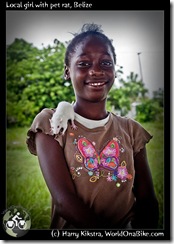 There are only 3 real roads in Belize, aptly named: The Northern Highway, The Western Highway and the southern Highway, all ending/starting in centrally located Belize City. Even so, there was almost no traffic on the Northern Highway that we were on, and we followed the gentle lines of the landscape without much bother of diesel-powered machines.
There are only 3 real roads in Belize, aptly named: The Northern Highway, The Western Highway and the southern Highway, all ending/starting in centrally located Belize City. Even so, there was almost no traffic on the Northern Highway that we were on, and we followed the gentle lines of the landscape without much bother of diesel-powered machines.
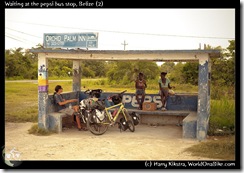 It was becoming a bit of a game to guess what language the people spoke and understood.
It was becoming a bit of a game to guess what language the people spoke and understood.
Though the official language is English, a large part of the population (the Maya) still only speaks Spanish and the ones that do speak English (mostly the dark-skinned Creole and Garifuni population) have their own pidgin variation of it, which would pass no teacher’s test.
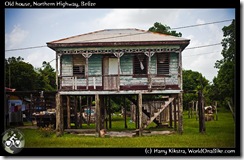 Then there are the Mennonites, who speak their own tongue (with elements of German as well as Dutch) and are important part of the population as they create about 45% of the nation’s food supply; dressed as if they were starring in the video clip of Weird Al’s Amish Paradise or stepping out of a 16th Century Dutch master’s painting.
Then there are the Mennonites, who speak their own tongue (with elements of German as well as Dutch) and are important part of the population as they create about 45% of the nation’s food supply; dressed as if they were starring in the video clip of Weird Al’s Amish Paradise or stepping out of a 16th Century Dutch master’s painting.
We found that bananas were still affordable here (8 for a B$) and discovered a new treat: ideals. Frozen bags of hyper-sweet lemonade in different flavours, well worth the 25cts the small shops charged.
Some Mayan kids at the ideal shop, enjoying their own goods as much as we did:
Belize hospitality
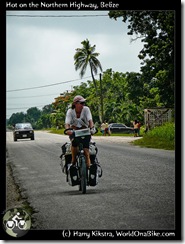 We passed around the larger city of Orange Walk and ended our day in a small town of Carmelita. The shops and restaurants were closed, save one, but the 2 dark-skinned guys were so unfriendly that we rather went hungry than giving them business. When asking for a place to camp, a nice young guy named Junior insisted we would join him to his family’s house, and thus we went.
We passed around the larger city of Orange Walk and ended our day in a small town of Carmelita. The shops and restaurants were closed, save one, but the 2 dark-skinned guys were so unfriendly that we rather went hungry than giving them business. When asking for a place to camp, a nice young guy named Junior insisted we would join him to his family’s house, and thus we went.
We cooked our emergency spaghettis and pitched our tent inside a small building next to their home, to ward off the hordes of mosquitoes. The night was incredibly hot and we did not sleep much. Outside one of the poor dogs was doing a constant and sad ‘silly walk’ as a result of a wrongfully executed injection.
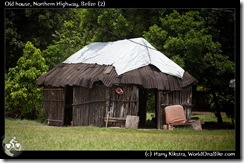 The chip-sealed road did not change much all the way into Belize City. We passed some small towns, old houses that were mostly looking like they could collapse any day, while the lawns were trimmed neatly as for a garden contest. It was a strange mix of poverty and a spacious country.
The chip-sealed road did not change much all the way into Belize City. We passed some small towns, old houses that were mostly looking like they could collapse any day, while the lawns were trimmed neatly as for a garden contest. It was a strange mix of poverty and a spacious country.
We were surprised that though Belize offers all kinds of fruit and food possible, none of it is being sold on the side of the road, as happens everywhere in Mexico.
The shops –and many restaurants- in the towns are mostly Chinese owned; the tasty pupusas on the streets are made and sold by Salvadorians, the handicrafts by Guatemalans, the food produced by the Mennonites and the ‘eco-resorts’ owned by imported Europeans and US-Americans. The ‘Belizeans’ seem to prefer to just swing around in their hammocks instead.
None of the rich mix of fruits and vegetables that is still somehow produced in Belize seem to make it to the local shops though and the restaurants mainly serve a variation (‘fry’ chicken, ‘fry’ beef or ‘fry’ fish) of ‘Rice & beans’.
Belize City, not so relaxed
We were warned that though most of Belize country is quite relaxed, Belize City is where all the criminals of the country seem to congregate. Though it was not as bad as foretold, it was definitely annoying to walk and cycle in a city that will turn everybody into a racist within moments.
All the shops seem to be owned by Chinese who try to make an honest living and are generally friendly. 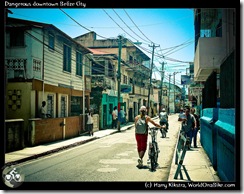 The streets in front of the shops are filled with young black males though, many of them either stoned or drunk (this is during day time) and most (!) of them trying to take my sunglasses, bicycle, money and whatever they could get their hands and eyes on. At least they did not use any violence, but simply ‘asked’ for it.
The streets in front of the shops are filled with young black males though, many of them either stoned or drunk (this is during day time) and most (!) of them trying to take my sunglasses, bicycle, money and whatever they could get their hands and eyes on. At least they did not use any violence, but simply ‘asked’ for it.
‘Hey man, lemme try those shades man’, while already reaching with both hands for my sunglasses which I was, well, wearing.
‘Gimme that bike man, it looks expensive my friend’, ‘Gimme some money man..’; ‘MMhheuuyww, yyeahh, hhmm?’ and similar Creole expressions.
Others tried to touch/grasp/take us and the few things we were carrying without saying much, which is just as annoying.
We were staying with a friendly CouchSurfing host named Jorge, a dermatologist, originally from Nicaragua. He took us to a nice area of town in the evening, but the moment we got our of our car, we were immediately approached and harassed by yet another ‘relaxed’ dude and apparently this was ‘normal’.
When walking back to his house the next night we felt not just annoyed, but threatened when two young guys on bicycles circled around us and then tried to block our way on the sidewalk without saying anything. Fortunately we were already in front of Jorge’s house by then, and could slip through his front gate without confronting them.
All in all, nothing bad actually happened, while we walked and cycled around town several times, so I guess you could say that it is a ‘safe’ city. But the general atmosphere is negative and threatening and too many young black males seem to live of ‘being relaxed’ and are trying to make easy money.
At least we did not encounter any violence as was reported in the local newspapers, where armed robberies, rapes and muggings were daily stories even in a small city like this (with only about 70,000 people living there). Maybe it was not me who was being racist, but the ‘homeless people themselves are’, as the great Chris Rock once pointed out in yet another inventive display of his inverted logic, ‘as somehow there are no Chinese or Gay homeless people’…
It was time to pick up my sister and nice from the airport as they were going to stay 2 weeks with us. Let’s see if the rest of the country would be friendlier than this seedy city.
Day 317-321, 24-28 May 2009: hot hilly roads, tropical fruits and friendly Mexicans
September 10, 2009 by Harry
Filed under Central Mexico, Mexico, North America, Trip reports
After our trip across the Sea of Cortez it was time to cross terra firma again. Only we were still not sure which route to take. It was clear that we would never make it in time to Cancun, to meet our mums, so what to do? 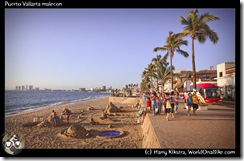
We decided to visit Puerto Vallarta first, as we could not believe that that such a famous place (The Love Boat!) would be nothing more than a collection of ugly resorts and polluted highways.
Our persistence paid off when we cycled over the cobbled streets of old Vallarta and onto the nice Malecon, the boardwalk. There were plenty of people about, artists, friendly beggars, loads of tourists, sand sculptors and even a set of oriental rope artists circling down from their platform.
 It was all nice, but it was also getting dark and we had no idea
It was all nice, but it was also getting dark and we had no idea
- where to go to, from Vallarta,
- where to sleep…
- and, most alarming of all: we did not have dinner yet!
As usual the solution to all questions presented itself without too much effort from our side. Just when we were checking our map of Central Mexico, a couple sat down next to us and asked about our bikes and trip.
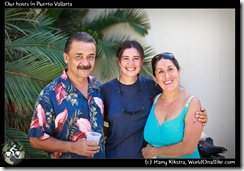 When I asked them in return about the different route possibilities – there is no straight way inland, you can go North and then East through Guadalajara, or South along the coast and then North again- they were sure that the coastal route was the best option: flat, narrow but quiet and only a few sections with drug-traffickers and other accompanying bandits. Sweet.
When I asked them in return about the different route possibilities – there is no straight way inland, you can go North and then East through Guadalajara, or South along the coast and then North again- they were sure that the coastal route was the best option: flat, narrow but quiet and only a few sections with drug-traffickers and other accompanying bandits. Sweet.
Cool, number 1 solved, and number 2 & 3 followed smoothly when they invited us for dinner and to stay in their house near the Malecon. Mexico is so full of friendly people, it looks like a complete different country than the media makes it out to be. Actually it is. Much, much better, as was and would be proven time and time again.
Day 317, 24 may 09: Puerto Vallarta – Near Tomatlan: 74km. Jungle to desert…
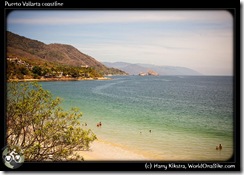 The next morning we were treated to nice tropical fruits for breakfast, pineapple and papaya! Real vitamins!
The next morning we were treated to nice tropical fruits for breakfast, pineapple and papaya! Real vitamins!
It was early but hot, but the coastal route was quite shady and showed us the hidden gems of the Vallarta Bay: nice beaches, amazing mansions and boutique hotels and lush jungle and fruit trees. 180 degrees difference from the dry desert of Baja California and even the rollercoaster road could not spoil our joy.
 That is, until the road turned sharply and went both inwards as upwards. The cool sea-breeze dropped and the temperature rose 10+ degrees within minutes, the jungle turned to desert and the road into a narrow steep wall with little space for our bikes. Our map showed that this would continue to 750m (2500ft) up, which did not seem like a great idea for our knees and general life expectancy, so we decided to take a lift, the first of many short ones along the Mexican South Coast.
That is, until the road turned sharply and went both inwards as upwards. The cool sea-breeze dropped and the temperature rose 10+ degrees within minutes, the jungle turned to desert and the road into a narrow steep wall with little space for our bikes. Our map showed that this would continue to 750m (2500ft) up, which did not seem like a great idea for our knees and general life expectancy, so we decided to take a lift, the first of many short ones along the Mexican South Coast.
Our friendly driver dropped us off at the top of the hill in El Tuito, stopping his ramshackle pickup only once on the way up, to buy some soft drinks for us, not accepting our money for it.
After lunch in the pueblito, we got to enjoy a nice downhill through pine forests and then a mix of dried shrubbery and other desert vegetation. We felt back in the Baja, seems that the Vallarta bay had been a one-off paradise. Soon the heat became unbearable, but though the Pacific Ocean should be near, no sign of it was noticeable, definitely no refreshing breeze.
The sun burned without mercy on yours trulies riding the undulating road and we had to stop several times for some shade, as well as to refill our bottles. We ended up just before sunset at a crossing close to the town of Tomatlan.
In Baja, it always cooled down at sunset, but over here, it still seemed to get hotter even. As we needed more water and it cost the same as a huge bag of ice, we solved two problems at once, cycling around the village with a large plastic bag with ice cubes, watched by curious Mexicans.
We found a friendly woman that would let us camp in her garden and even though we only put up our inner tent, it was so hot that we went to bed covered with nothing than our Ortlieb water bags and polarbottle, filled with the melting ice in a futile attempt to cool off…
It was still more than 30 degrees outside; the stupid guard dogs did not know whether to protect or attack us and the man of the house that returned drunk in the dark first fed bananas to the goats, and went back to the bar, only returning a short while later to vomit loudly in his car while abusing his helping wife. Life on a bike, always different, never far from reality.
Day 318/9, 25/6 may 09: Rollercoasting from Tomatlan to San Patricio 77+41km, 1400m up and down.
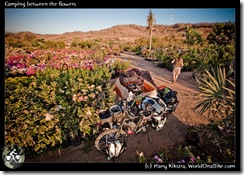 Just when we were mixing our newly discovered freeze dried soy-milk with cereals, a full-size truck pulled up at the gasstation. In the back stood more than 2 dozen kids, ranging in age from 8 to about 17. Innocent and naive as we were, we thought that this might be a poor-man’s version of a school bus, either to take the kids to school or to an excursion, as it was a weekday.
Just when we were mixing our newly discovered freeze dried soy-milk with cereals, a full-size truck pulled up at the gasstation. In the back stood more than 2 dozen kids, ranging in age from 8 to about 17. Innocent and naive as we were, we thought that this might be a poor-man’s version of a school bus, either to take the kids to school or to an excursion, as it was a weekday.
When Ivana asked the kids where they were going, the just replied with slent blank stares and took off again. The attendant explained that they were off to work in the fields, to produce the cheap fruit for export. No education for these and many other kids in Mexico, the only thing they learn is to work, and work hard.
We hit the ‘coastal road’ again but caught exactly one glimpse of the Pacific; most of the time we were just sweating up and down the few dozen smaller and bigger hills. Nothing too serious, just annoying in the sweltering heat.
Again the average temperature was above 31 degrees and we were happy that the friendly gardener that let us camp in his flowery vivero, offered us use of his garden hose and water-tank to freshen up at the end of the day.
An early start gave some refreshment, but after 35km –including already 700m/2300ft up !- it was hotter than ever and we started to curse our friendly Vallarta host that had recommended this ‘flat coastal’ road that was neither, and which we doubted he had ever been on. He definitely never had cycled it in his life.
Time for lunch, and things improved considerably when we stumbled on a nearly-deserted guesthouse, with swimming pool, fruit-dropping mango trees and an internet cafe. Heaven! Of course our lunch lasted longer than planned and we decided to camp here, being offered more mangos than we could eat. Life was not so bad after all.
Day 320, 27 May 2009: San Patricio – Manzanillo 76km, 370m up and down
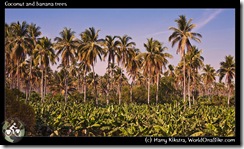 We had entered the state of Colima, which we had been dreaming about since we found out that a large part of Mexico’s fruit originates here. We were not disappointed, as the bumpy desert abruptly had given way to fields of coconut palms, mango trees and banana trees, while smaller orchards and roadside stalls offered all kinds of other natural goodies.
We had entered the state of Colima, which we had been dreaming about since we found out that a large part of Mexico’s fruit originates here. We were not disappointed, as the bumpy desert abruptly had given way to fields of coconut palms, mango trees and banana trees, while smaller orchards and roadside stalls offered all kinds of other natural goodies.
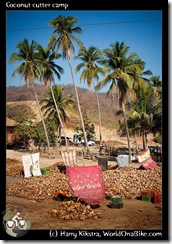 A few women were chopping enormous piles of brown coconuts in half; they only collected part of the fruit for the cosmetic industry, discarding both the juice as well as the tasty heart, so we filled up our bottles rather than letting the healthy water flow onto the thirsty sand.
A few women were chopping enormous piles of brown coconuts in half; they only collected part of the fruit for the cosmetic industry, discarding both the juice as well as the tasty heart, so we filled up our bottles rather than letting the healthy water flow onto the thirsty sand.
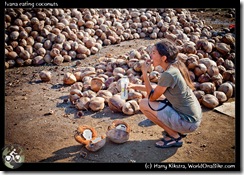 There were many mango trees with thousands of fruits dropped onto the forest floor. Apparently due to the transportation and export (to the US) hassle and cost, it is too costly to harvest and sell them so they just rot away. Except the ones that fitted in Ivana’s big Ortlieb bag of course
There were many mango trees with thousands of fruits dropped onto the forest floor. Apparently due to the transportation and export (to the US) hassle and cost, it is too costly to harvest and sell them so they just rot away. Except the ones that fitted in Ivana’s big Ortlieb bag of course ![]()
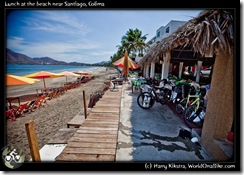 As an added bonus, the road was nearly flat and we not only got to see the ocean, we even got to touch it when stopping for lunch near a nice swimming beach.
As an added bonus, the road was nearly flat and we not only got to see the ocean, we even got to touch it when stopping for lunch near a nice swimming beach.
What goes up has to come down, even when not literally, and things deteriorated seriously after lunch. Traffic increased to annoying numbers when we approached the busy city of Manzanillo. Lack of signs made us follow a dead end street to the harbour for several km. Noise and exhaust of the buses, cars and freight trains rose to lethal levels and to top it, we got into a huge fight about which route to take. In the end I gave in and up and let Ivana decide, resulting in another detour of several kilometres.
After 75km we were more than exhausted and while still angry we rung the doorbell on a house that had a big gate and a nice garden; both necessary for a safe camp in an urban zone.
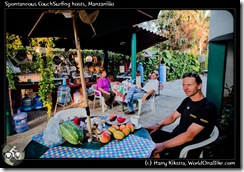 An elderly couple opened up and listened to our story. Soon they invited us, not just for dinner, but also to use one of the extra rooms upstairs, so instead of fighting and sweating in our tent, we got a shower, Mexican food and a ventilator to cool us down.
An elderly couple opened up and listened to our story. Soon they invited us, not just for dinner, but also to use one of the extra rooms upstairs, so instead of fighting and sweating in our tent, we got a shower, Mexican food and a ventilator to cool us down.
We deserved it.
Day 321, 28 May 09, Manzanillo – Boca de Apisa, 91km
 The fruity flatness continued and though the average temperature was above 31C/ 88F again, it was still a relatively pleasant ride though the field, only interrupted by a few hours of lunch in a truck-stop to avoid the heat and a short visit to the ugly City of Tecoman.
The fruity flatness continued and though the average temperature was above 31C/ 88F again, it was still a relatively pleasant ride though the field, only interrupted by a few hours of lunch in a truck-stop to avoid the heat and a short visit to the ugly City of Tecoman.
We were aiming straight for some nasty looking hills, but turned right before reaching them, back to the direction of the Ocean. We did not notice that our total recorded distance had silently increased to a 5-figure number until later that night, 10,000km (6250mi) on the road!
We had been looking forward to camping on the beach, but when we followed the 5km/3mi long turnoff, we discovered that the road literally ended at the ocean, with just a few meters of sand separating us from the big powerful waves.
 Armed with nothing much more than the knowledge that we had entered drug-trafficking country we were not being overly comfortable with the stares of some local youth and the lack of water and safe places.
Armed with nothing much more than the knowledge that we had entered drug-trafficking country we were not being overly comfortable with the stares of some local youth and the lack of water and safe places.
So, tired as we were, we headed back up to the main road and asked a farmer if we could pitch a tent on his land, which was situated next to a military checkpoint.
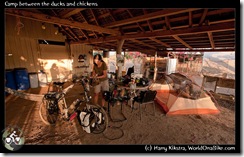 As there were dozens of different feathered friends around, Ivana preferred to camp under the roof. After being chased into our hot tent by a battalion of nasty mosquitoes, we fell into a restless sleep, blissfully unaware of the fact that I would visit 3 different doctors in 3 different hospitals in the next 24 hours…
As there were dozens of different feathered friends around, Ivana preferred to camp under the roof. After being chased into our hot tent by a battalion of nasty mosquitoes, we fell into a restless sleep, blissfully unaware of the fact that I would visit 3 different doctors in 3 different hospitals in the next 24 hours…
Kowalski! Status report!
 Mangos eaten: countless
Mangos eaten: countless- Metres climbed in 5 days on the ‘flat coastal road’: 2500+
- Average temperature during those 5 days: 31C/88F.
- Km cycled since Prudhoe Bay, Alaska: 10,020!
- Vertical meters/climbed since PB, AK: 83,460 (52 miles)
- Santos Travelmaster problems: zero.
- Knee & back report: positive, taking care and working fine.
Here are the road profiles, for those masochistic enough (or smart enough to cycle this in winter) to take it on:
Day 297-299, 4-6 May 2009: Baja California Sur, pt3: through the desert to La Paz
August 19, 2009 by Harry
Filed under Baja California, Mexico, North America, Trip reports
Note: only a few photos in this report as the scenery was quite boring and often it was too hot to stop for photos, but instead some more stories, hope you like them as well!
We had been advised to take a ride as the last section to La Paz would be ugly and boring. We had cycled over 1100km/700mi in Baja California so far, and still had more than 300km/200mi to go before we could rest in la Paz and think about the crossing to the mainland.
4th May 2009: from the beach to the dust & food confusion: Juncalito – Ciudad Constitucion, 97km (+40km ride)
We said our good byes to Roberta and headed our loaded bikes back onto the main road. We passed the exit to Puerto Escondido this time and continued over relatively flat roads. The walls of the mountain range we had to cross looked down upon us with indifference.
We had read in an old guidebook that the next climb was one of the longest, steepest and most dangerous of the peninsula and had decided we would try to get another ride, as the combination with the heat and lack of sea-wind would be a horrible way to wreck my knees again.
Just at the bottom of the hill we found a new bridge with a nice wide shoulder where we parked our bikes and flashed our thumbs up at the passing pick-up trucks. Soon a nice man stopped in a huge SUV; we loaded the bikes, headed into the air-conditioned cabin and quickly made our way up 40km of steep and narrow ascents, very happy we were not pushing our bikes on the black tarmac.
He was going all the way to Ciudad Constitucion and asked if we wanted to join him to there, but we declined. It is always a hard decision when somebody offers a ride, especially when it is hot, windy and boring, but we have come here to cycle and felt bad enough about the ride so far.
He dropped us at the highest point and as the wind was in our face, we enjoyed the constant downhill towards the city. But soon the road turned horizontal, while the wind picked up in speed and temperature and soon we found ourselves fighting the giant blow-dryer at 10km/6mi per hour, while cursing ourselves for not being in an air-conditioned car when we could have been… We stopped exhausted in Ciudad Insurgentes and treated ourselves to some refreshing liquados.
Fortunately the road had made a 90 degree turn when reaching the city and the last part the wind came from the side and even from the back and we were in Ciudad Constitucion quickly. Traffic was very busy between the cities but the road wide and we had no problem. What turned out to be more difficult was finding a place to sleep in the city. We asked several people with gardens and even the Police for a place to pitch our tent, but all turned us down. It was already close to dusk when we left the city, trying to find a place outside of town.
Only a few minutes outside the city limits I noticed a great garden. The house was deserted, but a little ahead were some people underneath a row of fruit trees. Sure, it was ok to camp and if we needed some sweet grapefruits? They were intrigued by our trip, or tent and our stove, but when Ivana started to cook our daily pasta meal, problems began.
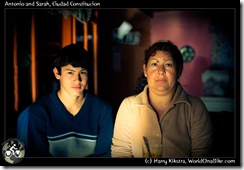 Sarah, the mother of the bunch, looked at our meal and then at us and back at the spaghetti again.
Sarah, the mother of the bunch, looked at our meal and then at us and back at the spaghetti again.
‘Que es eso, sopa?’, ‘What is this, soup’?’
‘Pasta! We eat if every night, good energy and tasty!’
‘Hmm. But how are you going to eat it?’, she replied.
We looked at eachother. ‘Well, we have a very nice tomato sauce today!’
Sarah looked perplexed.
‘Y como lo va a comer?’, ‘How are you going to eat it?’ she repeated, this time a bit louder.
As my Spanish is not so good, I was not sure if I had understood her correctly, but Ivana’s face looked just as puzzled as I felt. Ivana tried a different answer.
‘Well, we have a fork and a spoon, Harry has a foldable plate and I eat from the pot, look.’ and she showed Sarah our limited but useful cutlery and cooking gear.
No, that was clearly not the right answer, either. Sarah called her son.
‘Antonio!!! Come here. Go to the tortilleria and get the gringos some tortillas!’.
A few minutes Antonio came back –on his bike!- with a full kilo of hot tortillas. Sarah handed them over and said that at least we now had something to eat our soup with. She also served us delicious fresh and sweet juice, but clearly was still shaken from the thought that somebody would even think about having dinner without tortillas…
5th May 2009: 110km through the desert, from Ciudad Constitucion to El Cien.
Early next morning we shared or peanut butter sandwiches with Sarah and her kids and took off. The road was still flat, the wind was still good and we had a good average on the first 55km. Then slowly we headed more inland again to cross the peninsula for the last time and things turned bad again.
The hills started to come and together with the road, the temperature rose with every pedal stroke and soon crossed the 35 degrees (95F) mark again. It was time to stop for lunch, but there was no shade anywhere and the few restaurants were all closed or demolished.
Finally, after 80km of cycling, I stumbled into a small loncheria and ordered a cool refresco under the hot tin roof. A few other customers did not believe that I cycled Baja California, let alone from Alaska and looked at me as if I were a Martian. soon Ivana arrived as well and slowly they got convinced I was not 100% insane after all, though at the same time they realized what we had done, they clearly did think we were mad as a rusty doornail.
In the back room was an old abuela, sitting in a rocking chair, watching TV, shouting orders to various grandchildren running about. ‘Change the TV channel! Get me a drink! Stop shouting!’. While we were dozing off with our heads on the table, we suddenly heard her shout again.
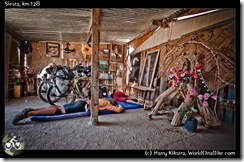 ‘Braulio! Get some colchonetas for the Gringos!’.
‘Braulio! Get some colchonetas for the Gringos!’.
And lo and behold, the little guy named Braulio arrived moments later with 2 large blue plastic-covered foam mattresses for us to sleep siesta on! We thankfully rested our tired bodies under the watching eye of yet another Virgen de la Guadelupe, and various other items that might need to be returned to the Museum of Bad Taste soon…
When the temperature had dropped slightly, we hit the dusty road again and rollercoastered to ‘El Cien’, (‘The Hundred’), simply named after the 100 km sign, indicating the remaining distance to La Paz. We got another tempting offer to hop in a car and arrive in La Paz that same night, but declined. We refilled our water bottles in a restaurant and made camp behind a deserted house, watching the stars fall and the police check random vehicles.
6th May 2009: back to sea through hills, heat and a tornadito: El Cien – La Paz, 105km, 750m up, 850m down
Today we planned to finish our trilogy of 100km days and get all the way to La Paz. The good thing about the desert is that it actually cools down considerably at night and when we left at sunrise, the air was fresh. We even encountered some fog on our way, but soon it was just down to the sun, the hills and us again. There was not a flat bit, all either up or down, but definitely more up, both in time as in distance.
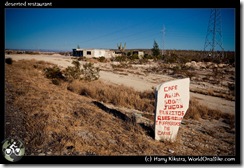 Also here the few buildings and towns on the map were physically or functionally not there and after 50km we were longing for some shade and a drink. It took us another 2 hours and dozens of hot hills before we stumbled in a small shack where they had a working and filled refrigerator. Another guest showed us the centipede he just caught: huge and poisonous, it just fit in a plastic 600ml Coke bottle.
Also here the few buildings and towns on the map were physically or functionally not there and after 50km we were longing for some shade and a drink. It took us another 2 hours and dozens of hot hills before we stumbled in a small shack where they had a working and filled refrigerator. Another guest showed us the centipede he just caught: huge and poisonous, it just fit in a plastic 600ml Coke bottle.
They mentioned that there were bigger restaurants just a mile up the road and so we continued a few minutes and stopped for siesta. We had some ramen noodle soups left and cooked ourselves some lunch when Ivana said that a tornado was coming. I thought she was listening to the loud radio that I had completely blocked out and asked her where and when.
‘There!’ she said and pointed behind me. A thin but high dust-devil slowly crossed the road and came towards the shop next door, selling 2nd hand goods. It looked like just another collection of twirling dust, but once it hit the neighbours’ shack, several large metal pieces of roof came off and flew several meters through the air. After it passed, Ivana went to check, but apparently nobody got hurt. The little boy from the shop came in as well, almost falling over from laughter and joy. He could hardly speak, but pointed up in the sky behind him and managed to utter a few words in Spanish, roughly translated as’ The dog was flying!’ before he fell over laughing again. Life in the desert…
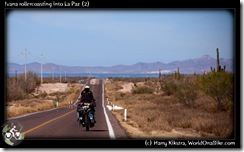
 Only when we walked a few meters outside, we noticed that we were on the summit of a hill, not far from La Paz.
Only when we walked a few meters outside, we noticed that we were on the summit of a hill, not far from La Paz.
It was basically one 20km long downhill to the city’s edge. We enjoyed the nice slope, only interrupted by some low-grade rollers and before long, we reached the coast and after cycling some very busy roads entered the charming center of La Paz. We bumped into the French in their RV again and then went to find a WiFi spot to check if any of our CouchSurfing requests had been answered…
Coming up soon: heaven in La Paz, new oil, free ferry and cruising The Net
Kowalski! Status report!
We spend about a month cycling from Tijuana – La Paz, stopping in several places along the way. We took some rides (probably about 100km together) and cycled about 1430km (900mi). After the flat tire on the first stretch we had zero flats, nor any other problems with our bikes.
My knees held out well, not getting better, nor worse, but I had very few problems with my back. Ivana had gotten sick from eating bad food, but that passed in a few days time. All in all a hard but satisfying experience, that we would not have liked to miss out on… More reflections later, for now here are the trip sections as described above:
Day 286-291, 23-28 April 2009: Baja California Sur, pt1: Across Baja, records, annoyances & Oases
August 10, 2009 by Harry
Filed under Baja California, Mexico, North America, Trip reports
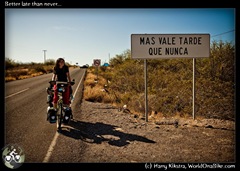 Finally, we have time to sit down and write some more trip reports… As the sign on the right says: better late than never, right?
Finally, we have time to sit down and write some more trip reports… As the sign on the right says: better late than never, right? ![]()
We have been enjoying Mexico a lot, we will try to get you updated on this wonderful country, filled with friendly people.
So what happened? The last report ended just above the 28th Parallel, which separates Baja California Norte from BC Sur (South). Different name, still a desert ![]()
We stayed 2 nights in a roadside motel, as Ivana was not feeling much better. Coincidentally, we started to hear the first stories about some strange flu that was spreading in the mainland, just after we had booked flights for our mums, who are coming to visit us in East Mexico, the end of June. Maybe that is why the hotel staff looked so suspiciously at Ivana? And why was the biggest Mexican flag we had ever seen suddenly gone from the state-crossing? It was time to move on and for once (!) the fabled Baja wind was in our back:
26 April 2009: 28th Parallel – San Ignacio, 159,25km!
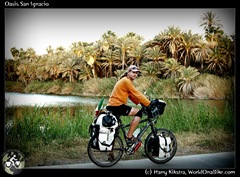 Yes! We beat our previous distance record and by a large margin, 40km more! After a quick stop in Guerrero Negro, we zoomed through the boring desert. We were too late for the famous whale season, so we had to make do with a cheeky coyote instead. A quick lunch in a most depressing dust-covered town called Vizcaino and then back on the pedals.
Yes! We beat our previous distance record and by a large margin, 40km more! After a quick stop in Guerrero Negro, we zoomed through the boring desert. We were too late for the famous whale season, so we had to make do with a cheeky coyote instead. A quick lunch in a most depressing dust-covered town called Vizcaino and then back on the pedals.
‘Come on Ivana, we still have 50km to go!’
‘But I thought you said we would do 100 today?’
‘Nope, I said 140!’. Lost in translation again, and a soft grumble was my reward.
It turned out that our map had an unmarked section (distance-wise), so that is why we found ourselves still on the bike after 130km. We decided we might as well enjoy the wind and continue to San Ignacio, a well-known oasis in the middle of the desert.
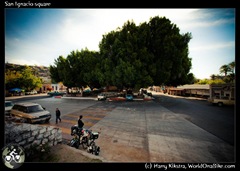
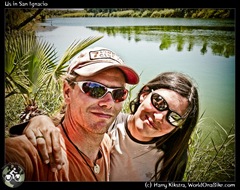 We made it just before dark and marvelled at the strange sight of fresh water (the first non-sea water we say since leaving Ensenada) and palm trees. After a quick tour around the charming plaza and an inventory of too expensive hotels and campsites, we made our camp on on a deserted property nearby only used for alcohol-consumption by some friendly locals.
We made it just before dark and marvelled at the strange sight of fresh water (the first non-sea water we say since leaving Ensenada) and palm trees. After a quick tour around the charming plaza and an inventory of too expensive hotels and campsites, we made our camp on on a deserted property nearby only used for alcohol-consumption by some friendly locals.
The next morning we found the place that our fellow biketravellers had been writing about: Casa Leree, a small and homely B&B near the plaza. Owner Jane, who is working on chronicling a photographic history of San Ignacio, offered us to stay for a few hours so we could work a bit using her Wifi, and even gave us some snacks for the road.
25 April 2009: San Ignacio – Santa Rosalia, 81km, 830m up, 888m down
The next day was one of those annoying days. Annoying because we had to start with a steep uphill, forcing us to push our bikes in the first kilometers. It seemed to improve a bit with some nice downhills, but then it got very annoying using a gazillion ‘vado’s, small ‘rollercoasters’. Up. And. Down. Rinse and repeat.
It was followed by some extremely annoying stretch: a fierce headwind on a gentle but constant and 25 km long slope. Uphill that is. It made me check my back wheel and tire every few minutes as it felt I was rolling two flats, but alas, it was just lack of horizontality, strength and freshness, both inside as well as outside my tired body. The desert did not seem to end and the only positive point in the heat was that the really big hill, Volcano Tres Virgenes, was clearly to steep to climb, so somewhere on it’s flanks must be a downhill hidden somewhere.
 It did come, but the full speed drop was too steep and curvy for comfort, only brief and followed by yet another slow climb in even harder wind, while the only shade offered was some itchy and prickly bush on the side of the road.
It did come, but the full speed drop was too steep and curvy for comfort, only brief and followed by yet another slow climb in even harder wind, while the only shade offered was some itchy and prickly bush on the side of the road.
The only entertainment was a vulture eating a very flat 5-foot snake off the road, but the rare but aggressive traffic that day made me focus on my handlebars rather than my camera. We managed to get some water off a nice old guy who lived alone in a house. There was a sign with some cutlery on the road, but he looked as if he had never seen it before and food was not to be found.
Ok, we were getting really close to Santa Rosalia no and still had several hundred meters to descend, (it was rather safe to assume that the seaport of the town was actually at sea-level). A series of warning signs about the upcoming drop convinced me that I should wait for Ivana and while I posted next to the road, a huge and fast caravan of policecars and SUV’s rushed by at an insane speed. Some buses and pick-up trucks that apparently either got sucked into their slipstream or just hypnotized by the flashing police lights followed, all about 25cm apart and like a suicidal metal conga line of madness they dropped down the steep road together.
One of the last drivers had motioned to me excitedly, while motioning backwards. I did not see Ivana, so I headed back up the steep hill, but she appeared before i reached the top, totally angry and very shaken. The cars, under leadership of the police, had driven her off the road and almost hit her with their crazy antics. I tried to calm her down as we had a dangerous slope ahead. In fact is was also annoying: I hate it when you spend 25km going uphill and then you lose all height gained on a slope so steep (I guessed 12-14%) and curvy that we need to brake all the way down. The road was lined with crosses for those whose brakes were less strong than ours, maybe Magura should make some brakes for pickups as well…
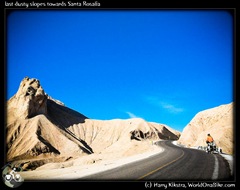 The annoyance was not over yet as we got another few small but nasty uphills, before we finally could go down to sealevel and cruise along the Sea of Cortez towards the town.
The annoyance was not over yet as we got another few small but nasty uphills, before we finally could go down to sealevel and cruise along the Sea of Cortez towards the town.
‘A French town’ it was called in many guidebooks. Guess the authors have never been in France. It did have its own charm though, but the problem with all the houses built close together, was that there were no gardens and therefore no camping space. We had cycled all the way to the end (up) until we reached the scrubby neighbourhoods our guidebook had warned us about; plenty of stares but no place for our tent. We asked the Police and Firemen, but they were too busy guarding tonight’s fiesta.
 The fiesta turned out to be a very long boring speech by the governor in which he proudly proclaimed that he did had done parts of what he was hired for in the first place. While we ate a large pizza next to the square, with our bikes rolled next to our table on the patio, it seemed that we had located the missing Mexican flag as well, nicely hung behind the politicians.
The fiesta turned out to be a very long boring speech by the governor in which he proudly proclaimed that he did had done parts of what he was hired for in the first place. While we ate a large pizza next to the square, with our bikes rolled next to our table on the patio, it seemed that we had located the missing Mexican flag as well, nicely hung behind the politicians.
They were probably the ones arriving late and almost killing Ivana on the way with their escort. The ‘party’ and the day ended with very loud and very annoying music, but even though we pitched our tent just 3 blocks away, in the driveway of the Red Cross, we were off to sleep soon…
26 April 2009: Santa Rosalia – Mulege, 68 km, 500m up and down
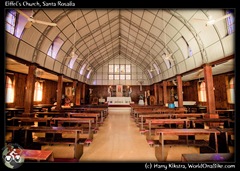 Some time between the moment we rested our head and the moment the dogs woke us up in the early morning the party had ended and upon closer inspection the town was quite nice.
Some time between the moment we rested our head and the moment the dogs woke us up in the early morning the party had ended and upon closer inspection the town was quite nice.
We found the claim to fame: Eiffel’s church, which was not only special because it was designed by Eiffel, of the Parisian Tower (and Lady Liberty’s frame, how’s that for Freedom Fries!) fame, but also because it is the world’s first know prefab building, packaged in boxes and reassembled here.
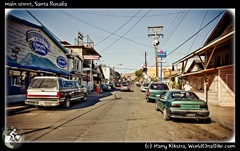 The other famous place, the bakery, was less impressive than any random counterpart in France, but still supplied us with enough carbohydrates to head into the dusty desert again.
The other famous place, the bakery, was less impressive than any random counterpart in France, but still supplied us with enough carbohydrates to head into the dusty desert again.
 I actually had a good day on the bike, but Ivana had it tough. More hills, heat, road construction –BC Sur seems richer, they are actually building nice bridges to replace the annoying and dangerous vado’s- and roadside grave markers.
I actually had a good day on the bike, but Ivana had it tough. More hills, heat, road construction –BC Sur seems richer, they are actually building nice bridges to replace the annoying and dangerous vado’s- and roadside grave markers.
 On top of a hill I saw a naturally flowing valley heading to wards our destination around some steep hills and told Ivana that we were almost there, just 10km more, all downhill.
On top of a hill I saw a naturally flowing valley heading to wards our destination around some steep hills and told Ivana that we were almost there, just 10km more, all downhill.
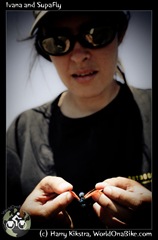 Alas, the awful truth was slightly different from the deducted version. Even though the psychopathic engineers that had decided that the roads better go over those steep hills were the true culprit, I was of course the bad guy, but the mood cleared when we saw the nice oasis of Mulege, another palm tree-covered surprise in the desert.
Alas, the awful truth was slightly different from the deducted version. Even though the psychopathic engineers that had decided that the roads better go over those steep hills were the true culprit, I was of course the bad guy, but the mood cleared when we saw the nice oasis of Mulege, another palm tree-covered surprise in the desert.
We had to search all roads in the village before we found the house of Bill, our host for the night, but once we arrived we could enjoy the fact that we had had yet another nice day in Baja, and according to the the stories of travellers before us, the best had just started…
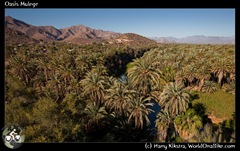 We stayed 3 nights in Mulege, relaxing and eating fish taco’s with Bill. He enjoyed our cooking and we could catch up with some work before heading into the last section of Baja California…
We stayed 3 nights in Mulege, relaxing and eating fish taco’s with Bill. He enjoyed our cooking and we could catch up with some work before heading into the last section of Baja California…
“Mulege is the safest place I have ever been, with regards to crime! There has only been one murder and that was a gringo guy being stabbed with a barbeque fork by his gay lover!” according to Bill.
The biggest danger is coming from the skies and sea though: the hurricanes have hit Mulege hard, with many houses -including Bill’s former place- being destroyed by Hurricane John in 2006. The water level of the river rose so much it touched the bridge (normally you can drive a big truck underneath) and many people had to run for their lives. Nowadays more big houses are being (re-)built and lots close to the sea and river are being sold to unsuspecting Americans. Though it is a pretty quiet place, you might want to read this post on the famous BajaNomads forum before you decide to invest in ‘this Piece of Paradise”…
here are a few pix from Mulege, let us know if you like them by commenting below!
Soon to come: Baja California Sur, pt 2
Kowalski, status report!
Knees: still ok! They hurt after cycling, but on the road they are quite fine. Santos Bikes are still stringer than the people riding them, they will probably outlive the human race…
Here are two tripsections as described above:
Day 281-285, 18-22 April09: Trucks, dust, wind, heat: Baja California Norte, Part2
April 30, 2009 by Harry
Filed under Baja California, Mexico, North America, Trip reports
18-21 April 2009, past San Quintin –Rosarito, via El Rosario, Sonora & the desert..
The roads were dry and empty but the fresh sea wind kept us cool. That is, until we headed inland and up a very steep hill. After some pushing we ended up at another military checkpoint on top of a mesa, before the road dropped quickly into the dusty town of El Rosario.
We bought some yoghurt and even though we had only cycled 50km, we decided to stay the afternoon and work in the Internet cafe. The previous owner was the current pharmacist and he send us to a place on the far side of town to pitch our tent: Baja’s Best.
It is a nice restaurant and B&B, run by ‘Eduardo’, American Edward Lusk, recognizable by the large ‘Starbucks’ sign on the side of the yellow building. Not sure if the coffee is from SB, but according to Ivana (who, unlike me, likes the beanjuice) the freshly made stuff was great.
When we go in for the evening, 3 drunk Mexicans are singing loudly. The youngest one starts messing with the friendly rottweiler Bruno, to the point that Bruno is about to attack. His two friends try to persuade him to stop, even lock him in his car, but somehow he manages to escape and stumble back in again. They are living proof that it is not wise to drive or ride after sunset on the Highway 1…
We camped on a nice patch of grass, a luxury in Baja and when we packed the next morning, Ed’s friend and neighbour Duffy came by. He was intrigued by our trip and bought us a breakfast in the restaurant.
We had been warned about the next section of the road, dangerous for all vehicles and cyclists in particular. Not only was it about 500m up, but the road was narrow, curvy and for some weird reason some curves were grading outwards creating danger for trucks.
As we would spend the next day pushing up most hills we decided to take a ride and got one a minute later, with Angel, a nice guy from La Paz. He mentioned that there had been some car-jacking on this section and that not everybody might stop for hitchhikers.
We quickly passed steep hills and very narrow corners and felt the centrifugal forces resulting from the road-designers’ engineering mistakes from the back of the pick-up.
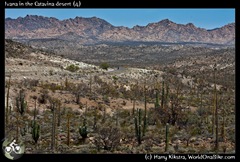 After about 60km we got out and started cycling and immediately regretted not having stayed on another minute as the road climbed up steeply out of a small valley. But even worse, once we got to the top, we almost got blown off the road.
After about 60km we got out and started cycling and immediately regretted not having stayed on another minute as the road climbed up steeply out of a small valley. But even worse, once we got to the top, we almost got blown off the road.
A gale-force wind was coming from the East and as we were headed SouthEast, it was almost impossible to cycle. The dry dusty storm pushed us all over the place and every truck passing created dangerous vacuums. It took us over an hour on relatively flat ground to cover 10km and we were happy to get some shade and a soda in a small ‘llantera’ one of the many car workshops (‘Body & Pain_’ as I saw once in San Diego ![]() ) along the road.
) along the road.
 We headed up as well now and the speed dropped even lower and we quickly ran out of water as we were basically fighting a life-size blowdryer at full force. In a small restaurant we bought a gallon of water. We had to buy our first plastic container on the trip as there was simply no water to filter around, we were in the middle of the desert.
We headed up as well now and the speed dropped even lower and we quickly ran out of water as we were basically fighting a life-size blowdryer at full force. In a small restaurant we bought a gallon of water. We had to buy our first plastic container on the trip as there was simply no water to filter around, we were in the middle of the desert.
Another hour later we stopped at a place that was called ‘Sonora’ on the map, which turned out to be exactly one house on the side of the road. We decided to call it a day as we had only done 30km in over 3 hours and were completely exhausted. Santiago, the owner of the ranch and his son Alonso, let us camp outside and we watched the milky way, while the wind stopped exactly at sunset…
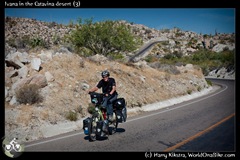 The next morning we left early to avoid the wind, but it had gotten up early with us. Still it was not as bad and we made it to Catavina relatively quickly. Catavina, the touristy little town in the middle of the desert of the same name was a depressing place.
The next morning we left early to avoid the wind, but it had gotten up early with us. Still it was not as bad and we made it to Catavina relatively quickly. Catavina, the touristy little town in the middle of the desert of the same name was a depressing place.
At 10 o’ clock in the morning we entered the local abarrotes, the name for the small minimarkets that were to be found in every dusty place in Mexico, selling basic un-necessities and some useful items like water.
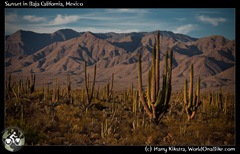 I saw a large electric waterfilter (‘Reverse OSmosis + UV!’) as asked the woman if we could refill our bottles.
I saw a large electric waterfilter (‘Reverse OSmosis + UV!’) as asked the woman if we could refill our bottles.
She said the filter was working and the water was safe, but when I checked the back of the machine the electrical cord and plug were tied in a not, covered with years of dust and spiderwebs, so unfortunately we had to purchase another plastic container…
The other clients all bought either beer, or coke and liquor, while the sun was still rising. We bought some refried beans burritos and some quesadillas and watched a half-drunk family get back in their battered old van, 6 people on 3 seats, the rest was on a mattress in the back, sipping litre-bottles of beer.
It was getting hot, so we headed back up the hills. Sometimes the wind was pushing in the back, then either it or we turned a bit and got mummified from the front. Ivana’s thermometer said it was 45 degrees Celsius (113F) and even though I drank more than one litre per hour, I could not pee a drop in a course of 2 days, the water just evaporated from our bodies.
Still it was a great place, giant cacti between graffiti-covered boulders lined the quiet road and we felt in a different world. The odd cirius trees were growing everywhere as well, simply a single almost-straight trunk, sometimes ending up divided near the top, but generally without any branches.
We had already climbed a lot during the day and as some places on the map were were out of business or simply did not exists, we had not rested during the hottest period. After another steep uphill where I had to again help overheated Ivana push her bike up, we were passed by a pick-up who offered us to take us to the next place. It was only 16km and most of it would be down-hill as we were on the highest point, but Ivana wanted to get out of the sun. The cold beer the guys gave us eased a bit of the pain of 10 minutes of driving down a nice steep slope.
We entered the small ‘Loncheria’ (where you can buy, yes you guessed it, ‘Lonch’) and had a short conversation with the sturdy woman behind the counter.
‘Buenos tardes (Good afternoon)!’ we greeted.
‘?Que queria?’ (What did you want?), was the reply.
We tried again with a greeting but got the same reply. We bought some water and asked if we could pitch our tent somewhere around the place.
‘There is a hotel somewhere.’, she pointed out towards the desert.
‘Where and how far?’ we asked out of politeness, adding that we were on bicycles.
‘There!’ she pointed again into the dust.
After this depressing person and similar place added enough tension between us to cause a short fight about taking rides, we decided to make some extra miles to make up for it and to enjoy the cooler afternoon air.
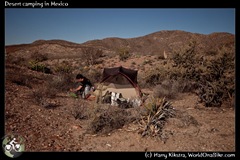 We had seen a small place called ‘El Crucero’ on the map, 29 km away. Even though it was late, we had some great down hills and the wind was suddenly pushing, so we made it just before dark. The only downside was that there was no place to be found anywhere.
We had seen a small place called ‘El Crucero’ on the map, 29 km away. Even though it was late, we had some great down hills and the wind was suddenly pushing, so we made it just before dark. The only downside was that there was no place to be found anywhere.
As we had to get off the road before dark, we followed a sideroad until we were out of sight and pushed our bikes into the desert. We were warned about the many spikes and cacti that had punctured so many a biketraveller’s tire and camping gear, so we carefully tried to remove the spikes from our path.
Stupid gringo as I am I tried to kick away a small fallen part of a cactus, but it punched right into my hard sole and managed to warp around, into my foot at the same time. I had to ask Ivana to pull it out, which took a lot more effort than getting it in…
We did not need to put the tent-fly, so if we hadn’t been so tired from this hot and hilly day (103km, excluding the 16km ride!) we could have watched the gazillion stars from our matresses…
We woke up to another hot day. We were sweating at 7 in the morning trying to get our bikes out the minefield of spiky things. Somehow I like the desert, but when all animals, plants and animate objects are apparently only put there to make life harder or even end it prematurely (in the case of some plants and many insects, snakes and spiders), it was good to be on the hot dark road again…
 We learned from our mistake and stopped before 11 o’ clock, lounging and lunching on some car seats on the patio of a small Loncheria until it was a bit bearable again. We had gotten a book from our host Gary, back in Oregon, and due to lack of power and Internet (though my solar panel was charging the batteries) I finally had time to start this great travelogue: Chasing Che: A Motorcycle Journey in Search of the Guevara Legend
We learned from our mistake and stopped before 11 o’ clock, lounging and lunching on some car seats on the patio of a small Loncheria until it was a bit bearable again. We had gotten a book from our host Gary, back in Oregon, and due to lack of power and Internet (though my solar panel was charging the batteries) I finally had time to start this great travelogue: Chasing Che: A Motorcycle Journey in Search of the Guevara Legend
We spent 4.5 hours in Punta Prieta, waiting for the sun to ease its angle on the Mexican part of the earth’s surface, while fat girls cared for babies with American toys. I managed to make the world a slightly better place by killing about 10 flies in the meantime. Guess that Buddhism, the last religion that had any hopes for me, also has given up by now…
It was still 40km to go to our next destination, Nuevo Rosarito and we rushed through the hills, over smaller and then bigger rollercoasters.
I waited for Ivana besides the road on one of the rare flat parts where you could see half a mile. Ivana was almost next to me, when an oversized SUV with Californian license plates, loaded with beach-stuff and two fat guys approached her with about 70 mile per hour (112km/h), swerving wildly to the left just before hitting her, then wildly back just in front.
All this on a clear road with no other traffic, perfect sight and a maximum speed of 30mph (60km/h). While passing they gestured maniacally with their hands indicating that we were crazy, to which I kindly attended them to the longest of my fingers.
Almost all large Mexican trucks always give plenty of space and wait when it is even a little bit unsafe to pass and then waive or honk friendly when they do, but somehow it is always the typical obese beach-yankee in their useless oversized SUV’s that think that they own the country, that are the biggest danger on the road…
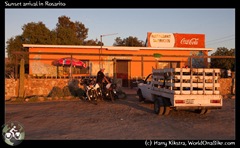 I was still pissed off when we zoomed down towards Nuevo Rosarito and stopped at the first restaurant we saw.
I was still pissed off when we zoomed down towards Nuevo Rosarito and stopped at the first restaurant we saw.
To celebrate the survival of our first real dessert we ordered some fried fish and camped our tent in the nice backyard, where we even discovered a hot shower!
But the night turned out less pleasant than expected. Not only were big trucks stopping all night long, their stinking diesel engines running stationary for hours before pulling out of the restaurant, but we both woke up feeling sick. I went into the bathroom and threw up my dinner, while Ivana passed it through the natural way, but at an unnatural speed and viscosity.
22 April 2009: with empty stomachs from Rosarito towards the 28th Parallel, 76km
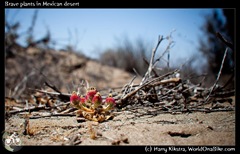 We felt weak but luckily the road flattened out after some minor climbs and even the road surface that for 10km had resembled something out of a horror movie rather than asphalt returned to Mexican normal.
We felt weak but luckily the road flattened out after some minor climbs and even the road surface that for 10km had resembled something out of a horror movie rather than asphalt returned to Mexican normal.
It was still hot and though close to the sea, the vegetation was mostly limited to thorny things and surprising amounts of a close cousin of the Joshua Tree, but I also discovered some tiny brave berries on the desert floor.
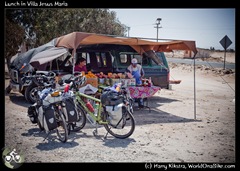 Halfway was a place called Villa Jesus Maria, not much more than a truckstop, where a nice family cut up a delicious fresh fruit mix on the spot. Ivana’s stomach was till upset and she due to her cramps she stuck with safer foods.
Halfway was a place called Villa Jesus Maria, not much more than a truckstop, where a nice family cut up a delicious fresh fruit mix on the spot. Ivana’s stomach was till upset and she due to her cramps she stuck with safer foods.
 The next 40 km were almost straight and as the wind changed from coming from the side to slightly from behind, we raced along the empty desert, passing many ‘vado’ signs.
The next 40 km were almost straight and as the wind changed from coming from the side to slightly from behind, we raced along the empty desert, passing many ‘vado’ signs.
It is hard to believe that these dips in the road have ever seen water, as we had not seen a drop of fresh water since leaving San Diego…
From miles away I could see a shape in the sky, that turned out to be a giant flag, rivalling the one in Ensenada for size, beating it in location: in the middle of nowhere.
The position was not as random as it might have appeared as we were approaching the 28th parallel. Not only a nice circle around the planet, but also the border between two Mexican states: Baja California Norte & Baja California Sur, the latter even being in a different time zone.
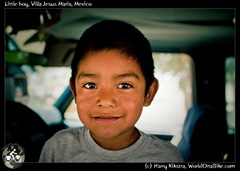 It was time to get my Internet fix and as Ivana was still feeling sick we checked in the first motel we saw with ‘Internet’ on the side.
It was time to get my Internet fix and as Ivana was still feeling sick we checked in the first motel we saw with ‘Internet’ on the side.
We got half price and awarded ourselves with an easy rest day before turning our clocks one hour ahead to Southern Baja Time. We survived the Northern part of Baja California. Not unscathed though and it is interesting to see what the even larger Southern part will bring…
Day 274-280, 11-17April09: Trucks, dust, wind, heat: Baja California Norte, Part1
April 28, 2009 by Harry
Filed under Baja California, Mexico, North America, Trip reports
We stayed a few days in Ensenada. Gerardo, who lives in the US, came down for a day, to resupply the local bikeshop (‘TNT’) with new bikes and parts and took us out for breakfast in the centre of Ensenada, where we visited a nice coffeeshop with Wifi. The town was virtually deserted, no tourist in sight.
Ivana’s knee was still hurting a bit, but we enjoyed the little house that Gerardo has opened up for cyclists passing South. We visited his friends Delia & Jose Antonio often and enjoyed just walking around the neighbourhood.
15th April, Ensenada – Santo Thomas, 35 km
 It was time to hit the road again and we made our way across busy streets. We noticed a lot of ‘Yonke’ signs and realized that it one more Mexicanisation of an English word, ‘junk’!
It was time to hit the road again and we made our way across busy streets. We noticed a lot of ‘Yonke’ signs and realized that it one more Mexicanisation of an English word, ‘junk’!
After I took a photo of the Romero Yonke, for my friend Romke Jonker ![]() , I turned to take a photo of Ivana approaching and almost shot her being run over by a truck that passed way too close for comfort.
, I turned to take a photo of Ivana approaching and almost shot her being run over by a truck that passed way too close for comfort.
It was going slow, but we were warned…
On top of a hill we saw our first of several military checkpoints. They check for weapons going South from the USA to Mexico and beyond and drugs going the opposite way, but never once did we have to stop, nor were our passports or bags checked.
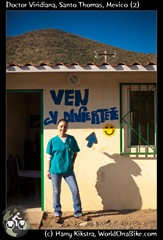 We did more climbing than expected and as Ivana started feeling some pain, we decided to call it a day in a small town of Santa Thomas. The local campsite wanted more cash than the hiker-biker sites in the USA, so we continued down the road to ask for a suitable place to pitch a tent.
We did more climbing than expected and as Ivana started feeling some pain, we decided to call it a day in a small town of Santa Thomas. The local campsite wanted more cash than the hiker-biker sites in the USA, so we continued down the road to ask for a suitable place to pitch a tent.
We found a small local hospital where a nice doctor was teaching the local and rural population about birth control, AIDS, nutrition and more.
She did not only share a nice ‘sopa de mariscos’ (seafood soup), but offered us the office to put our mattresses, so we did not even have to pitch a tent.
16th April, Santo Thomas – Colonet, 76km
We got our first taste of Baja climbing today, slowly climbing over a 450m high slope. The road was not too busy, but once we hit the steepest part, the road curved and we realized that although we could hear them coming from a kilometre away, the big trucks could not see us, so mostly we waited on the side of the road to let them pass.
We had seen many signs depicting ‘campsite’ along the way, but they never had any direction, explanation, name or distance attached to them, so we never actually saw one.
The town of Colonet seemed to be nothing more than just a few dusty convenience stores along the highway, but when we went in one of the side roads we found a nice central Plaza, where we could ask the Police for a place to camp.
We entered to see about 5 guys lounging lazily in comfortable chairs, watching some soap opera on TV. One managed to get up and showed us a place in the backyard, where we could sleep. When we headed to a nearby mini-market to buy our totopos (nacho chips!) and salsa and to refill our water bottles (cheaper and more ecological than buying bottles), we got a lot of positive comments from kids and elders.
One family that apparently already had seen us on the road got so excited that they invited us to their house for dinner. As they could not explain much more than ‘up and behind that steep hill’, we decided to put our bikes in their van and -after letting the police know that we wouldn’t be staying- off we went.
Gerardo and his family lived outside of town in a small place, erected by a church group. Around it a few dogs were keeping the cows away from the food for the pigs and the chickens. They also had a campervan, which was normally reserved for his 3 girls to study, but now they insisted that we use the bed inside after we shared our totopos and some quesedillas, sharing mutual stories, 7 people around the light of 2 candles…
17th April 2009: Colonet – past san Quintin
Gerardo, his wife and 2 daughters left at 6 in the morning to catch the bus that would take them to work on the fields, paying about $10 per person per day. We spent some time with the 3rd daughter, Areli and then headed out on the bumpy road, back to Highway 1.
Mexico Highway 1 is just a two lane-road, exactly 2 trucks wide, divided in half by a mostly uninterrupted non-passing line. As with all traffic signals (stop signs, speed limits and even distances to the next town), this is merely a polite suggestion, and rarely appreciated.,There is no room for a bicycle if two vehicles are passing each other, so we had to be watchful all the time and our little rear-view mirrors were lifesavers.
Fortunately a large part of todays trip, a small part beside the road was paved, creating a narrow shoulder as wide as 1-2 feet, just enough to make cycling a bit more relaxed.
We passed some busy parts, the area called San Quintin was full of large and small trucks, but right after, traffic was much rarer and the wind was finally in our back for a while. We noticed some regular patterns around the road: trash every meter, ripped car tires every 10 meters and a memorial sign looking like a grave amidst car debris every kilometre or so…
This area was home to many tomato & strawberry growers and we ended up camping at a rest area between big farms, while big trucks were roaming around non-stop.
Tomorrow: Part 2 of Baja California Norte!
Day 234-241, 2-9March 09. Back on the bike, LA to San Diego. Jai Ho!
March 11, 2009 by Harry
Filed under Trip reports
2nd March 2009: LA – Lomita via Santa Monica, 50km
 We spent one more day and night with Claudia and Diego, watched our new favourite movie, Oscar-winning Slumdog Millionaire (Jai Ho! became our new motto
We spent one more day and night with Claudia and Diego, watched our new favourite movie, Oscar-winning Slumdog Millionaire (Jai Ho! became our new motto ![]() ) and then we headed out again. We wanted to start again, where we had been picked up by Diego, so we actually first went North-west, back to Santa Monica.
) and then we headed out again. We wanted to start again, where we had been picked up by Diego, so we actually first went North-west, back to Santa Monica.
It took us about 20km right through Los Angeles, which simply confirmed itself to be a rather ugly place.
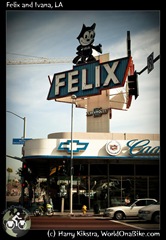 Not that we ever felt any danger (besides from ridiculously oversized trucks and SUV’s of course), most of the people on the streets were very friendly. But the roads are a mess (especially for such a car-centred society), trees and parks missing, and houses and streets dirty.
Not that we ever felt any danger (besides from ridiculously oversized trucks and SUV’s of course), most of the people on the streets were very friendly. But the roads are a mess (especially for such a car-centred society), trees and parks missing, and houses and streets dirty.
It reminded us more of something we had seen in developing countries than one of the most important cities of the USA.
Only when approaching the coast, the houses got cleaner again and the areas greener. We enjoyed the Sushi buffet one more time and headed down the coastline.
The weather was great again and we walked down the Venice Beach boulevard, receiving some small gifts and encouragements from the street vendors, the homeless and the neo-hippies. The route stayed nice, following the nearly deserted beaches all the time.
5 March: Lomita – Newport Beach, 60km
We had stayed two nights in Lomita, with a special host. Nepalese-born Shamu is the father of Japhy (Jeff), who is also cycling down from the US to Argentina. Just this same week, he had stayed with Ivana’s father and with her mother, both living close to each other in the San Juan province of Argentina, on the other side of the planet.
So while Jeff’s father was taking care of us, Ivana’s family was taking care of his son even though none of us had ever met before. That is the great thing about the hospitality of the CouchSurfing and WarmShowers hosts. Shamu also introduced us to one of his friends, who not only took us for a nice walk on the Redondo beach, but also taught us a lot about hydro culture and natural foods. Oh, and we watched Slumdog Millionaire again ![]()
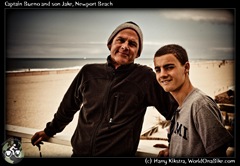 The section through Lomita and Long Beach was one of the most horrible so far, traffic wise, with no shoulders and thousands of trucks, but soon enough we were along the beach again, where the wind blew us swiftly past kite-surfers towards Newport Beach.
The section through Lomita and Long Beach was one of the most horrible so far, traffic wise, with no shoulders and thousands of trucks, but soon enough we were along the beach again, where the wind blew us swiftly past kite-surfers towards Newport Beach.
We had contacted Harry Barton through CouchSurfing but when we told him that we would stay for one night only, he stressed that he did not live near the beach, but on the beach ![]()
We ended up staying a few nights with ‘Captain Bueno’ (his LA radio alter ego from the 70’s) and his kids and enjoyed talking about politics, technology, travel and life in general, while catching up with work and blogs.
8th March, Newport Beach – Carlsbad, 80km
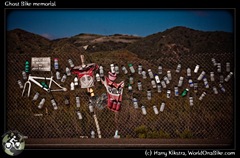 We kept cycling close to the beach on another hot winter day. Just before entering the Military Zone (where cyclist can pass through as long as they have ID and a helmet and arrive before about 1500 hrs), we passed a strange sight: dozens of drinking bottles and a bike frame and –jersey were hung on the side of the road, a tragic memorial to a killed cyclist.
We kept cycling close to the beach on another hot winter day. Just before entering the Military Zone (where cyclist can pass through as long as they have ID and a helmet and arrive before about 1500 hrs), we passed a strange sight: dozens of drinking bottles and a bike frame and –jersey were hung on the side of the road, a tragic memorial to a killed cyclist.
(edit: Steve Stuart send me the following correction/addition: “To clarify – it was a memorial but the the cyclist was the owner of a bike shop in San Clemente just north of there. He wasn’t “killed” but had a heart attack and passed away when riding at that spot. Your description sounded like a car hit him and I thought this was a little less depressing. At least he passed doing what he loved.”)
A bit further down the road we met a German biketraveller. Kris had just gone up from South America.
 He had his camera robbed in Colombia, when some girl pretended she was interested in him. It caused such an outrage and shame when the local TV and radio found out that he got donated a new camera and he got new lenses almost free as well…
He had his camera robbed in Colombia, when some girl pretended she was interested in him. It caused such an outrage and shame when the local TV and radio found out that he got donated a new camera and he got new lenses almost free as well…
Somehow we managed to miss the right entrance of the military zone and suddenly found ourselves on the broad shoulder of the busy Interstate 5. Cycling was actually allowed here as besides the army zone, there is no other road.
At least it got us into Oceanside quickly, where we found ourselves arriving in Redneck Heaven; what had happened to all the nice little beach towns? It was a mess on the street and every car seemed to have extra exhaust pipes for extra noise, oversized tires, loud paintings, darkened windows and even louder music. I wanted to ask the drivers if they were born stupid or raised that way, but probably none of them never even saw me (or anything else with those windows), so I had to let them off the hook.
Maybe it was just the influence of the military bases nearby, as fortunately the atmosphere improved considerably when approaching Carlsbad and that evening we found ourselves in a nice house behind a huge plate of delicious lasagne and salad, prepared by bike advocate Steve and his wife.
9 March 2009: Carlsbad – San Diego, 60km
My knee was doing the same as before: quite ok during cycling, but afterwards it was hard to walk and only ice and NSAIDS (anti inflammatories) relieved. Before reaching San Diego, we had a few hills to climb, but they did not pose too many problems. The many small towns on the way looked nice, we were really getting into the surf-and-relax area.
Our guidebook managed to show us the way through the busier suburbs like La Jolla. On one very busy uphill road, a car was parked on the bike lane, with the driver still sitting inside. I honked my horn several times, but he just waved in the direction of the busy road where cars were passing non-stop at 50miles per hour. As I was barely going 10% of that, overtaking would mean suicide…
So I had no choice but to climb up the sidewalk. Normally I let things like these go, but I felt angry and tapped his window, which he lowered after a while.
“Excuse me, but what part of ‘No Parking, Bike Lane’ you don’t understand?” I asked him, pointing at the signs.
“Eh, I, I am not from around here..” he stumbled, which made me angrier.
“So you also do not stop for STOP or other signs here?”. He did not know what to say and just looked straight ahead.
“I am sorry, I am not from around here…” is all that he could utter, at which point I thought it would be wiser for both of us to just go and continue the climb…
Finally, San Diego
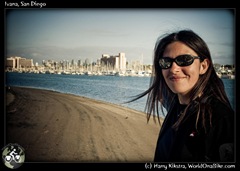 After more than 8000km/5000miles of cycling (of which 3000km in the Lower 48), we entered San Diego.
After more than 8000km/5000miles of cycling (of which 3000km in the Lower 48), we entered San Diego.
We arrived from the North West, first alongside nice beaches of Mission Bay, then along a busy road and finally a long shared walking/biking path alongside Harbour Drive. SD is situated nicely along some pretty bays and peninsulas, the weird thing is that the airport is exactly in the middle of several popular (and populous) neighbourhoods and every 2-3 minutes a jet would fly over the hills of Balboa Park, drop down quickly and land between a few highways. An accident waiting to happen and definitely not good for anybody’s health.
We worked our way up the steep hills of Broadway until we found the house of Daniel Wolf. We only stayed with him for a night, but he was the first of a few interesting hosts that would help make San Diego feel like home, a last stop before heading into the great unknown called Mexico…
Mile 207, Oregon Dunes National Recreation Area: a Trash Rant…
I am about to post several wonderful images of Oregon State, USA. A truly beautiful place. But first I have to get something else off my chest:
<rant> Imagine cycling along one of the most beautiful stretches of coastal nature in the US, maybe even in America. Dunes, forests, cliffs and rough waves. So nice they declared it a ‘National Recreation Area’!
I enjoyed the scenery, but got more and more annoyed with the trash that was on the side of the road. It got so bad that I could not focus on the nature or even on the traffic, but just on the next piece of plastic that had been thrown out of a car window, or maybe I should say truck window?
Besides the ugliness of the trash, the chemicals that are slowly released into nature (by decomposing and by getting eaten by animals), it also creates dangerous situations for cyclists, as many times we have to go around heaps of glass or large pieces of trash, forcing me onto the car lane (assuming there is a shoulder to begin with).
At one point, at the bottom of a steep hill, I decided to take some photographs.
About one mile later, I had about 75 pictures of discarded trash, all taken within 45 minutes of uphill cycling (some more were shot after lunch, one hour later). Please take the following facts in account:
- I only started shooting after I got really annoyed by all the trash, so there were hundreds pieces more, just before this series.
- All first 75 shots were taken within 45 minutes; this includes cycling uphill, getting off the bike, releasing the flap of my handlebar-bag, getting the camera ready, taking a picture and getting moving again. Mostly I could do only a few pedal strokes before stopping again.
- Many pieces are missing. Only halfway up I started to shoot ‘doubles’, before, I passed items if I already had shot them. Missed Doubles (or triples) include red Bull, Coca Cola, Camel cigarettes, all Beers Of Idiots (see below) and more
- I did not shoot most unrecognizable and/or unbranded pieces of trash, such as random car parts, plastic wrappers of all kinds and sizes, unrecognizable glass items and much, much, much more…
- The road was steep on my side, the side of this trash, so likely a multitude of trash was to be found lower down the slope
- It was busy and there was no good shoulder, so I could not stop for every piece.
- Image #27 is the one in the middle: Scenic Byway… Besides this sign, there had also been a ‘Adopt-A-Highway sign before I started shooting.
- I only shot one side of the road.
Here is it: all the glory of Mile 207, Oregon (click image for larger version)
Conclusions:
Not all of the below are scientifically proven or valid, but it after cycling several thousand kilometers along the US highways, it is reasonable safe to assume that:
- There are hundreds pieces of trash per mile of US Highway, even though it is in a ‘National Recreation Area’
- Coors & Bud (especially light) are the choice of beer for trash-throwing idiots
- There is just as much ‘healthy’ trash (waters such as Dasani, Aquafina, ArrowHead (with ‘Eco-Shape bottle’!), V8, VitaminWater etc) as there is stuff that was already trash to begin with (KFC, McDonalds, Taco Bell, BurgerKing etc etc)
- Drive-thru coffee creates throw-away empty coffee trash.
- Adopt-a-Highway seems nothing more than a scam where local businesses get some advertising and never look at ‘their’ road again. There were some exceptions in the US (especially notably when the Adopter was a Bikeshop or Eco-market etc), but generally those signs only seemed to attract trash as the idiots throwing things out of their car, seem to need something to aim for..
I assume that the crazy fools that throw these things out of their car window (trust me, they are NOT cyclists…) have zero respect for nature also have no respect for others or even themselves, as they are messing up their own planet. Is is just education? lack of proper values taught by their parents? Or just plain stupidity? I really wonder what goes on in their minds if anything at all.
Some places have a sign that says: ‘$1000 fine for littering’. This means that if one person was stationed here, he could have raised at least $80,000 in fines (likely a multitude) on this one mile alone. I think that will cover his salary? How’s that for job creation?
< / rant>
Water: refill, not landfill please…
November 19, 2008 by Harry
Filed under Go green, Tips & Tricks
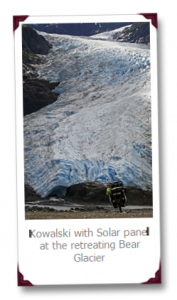 When cycling down from Alaska, we often asked passing RV’s for some water. We noticed that most of the time, people were carrying trays and trays of small 0.5l (16oz) bottles of water, which we normally refused. It appears that not many people are realizing that:
When cycling down from Alaska, we often asked passing RV’s for some water. We noticed that most of the time, people were carrying trays and trays of small 0.5l (16oz) bottles of water, which we normally refused. It appears that not many people are realizing that:
- You need about 3 liters/ 96oz of water per day, this means 6 empty bottles per person, so a lot of trash
- They pay much more for their water than they should
- Though many say bottled water is ‘safer’, they have no idea if the water is better than that from their taps as ‘sourced’ water does not have to disclose the ingredients…
- ‘Recycling‘ is merely downcycling (see the excellent book ‘Cradle To Cradle’): the bottles are not reused, they are just used as a low quality source for other products that also cannot be recycled, so just a few steps away from being landfill where they will end up..
It has become a habit to buy and take bottles of water (‘hey, water is healthy, right?‘), promoted by the powerful marketing machines of Pepsico & Coca-Cola and the shallow promise of ‘recycling’.
I can tell you that I have been using the same 2 bottles: 1 PolarBottle & 1 1liter waterbottle all the way from Northern Alaska to California. That’s right: just refills, with pure, delicious water. No trash needed… Here is some information that might educate and even surprise you a bit. Most of it is also sponsored by commercial companies like Nalgene (refillable bottles) & Brita (waterfilters), but I rather support those companies that try to pevent more trash.
On the side of this post is a small set of images; all shot within 20 minutes, while cycling uphill, all empty waterbottles, thrown out of cars by ‘healthy’ people…
Facts
| In the United States in 2006, bottled water consumption reached a record 8.3 billion gallons, 185 million gallons of which was imported. The total amount spent on bottled water was over $11 billion. (Beverage Marketing Corp.) | ||
| In contrast to tap water, which is distributed through an energy-efficient infrastructure, transporting bottled water long distances involves burning massive quantities of fossil fuels. Nearly a quarter of all bottled water crosses national borders to reach consumers, transported by boat, train, and truck. (Earth Policy Institute) | ||
| It costs more money to drink bottled water than to put gas in your car–up to five time more–due mainly to its packaging and transportation.(Earth Policy Institute) | ||
| Bottled water companies do not have to release their water-testing results to the public, whereas municipalities do. (Natural Resources Defense Council) |
Links
- Container Recycling Institute
- Earth Policy Institute
- National Resources Defense Council
- U.S. Environmental Protection Agency
- Bottled Water Blues
- Local Drinking Water Information. How is Your Tap Water?
- www.drinktap.org
(from http://www.refillnotlandfill.org/facts.html)
Learn the Facts
(from http://www.filterforgood.com/learn_the_facts.php)
Why is bottled water waste a concern? Here are just a few reasons…
- Americans used 50 billion water bottles in 2006 and sent 38 billion water bottles to landfills, the equivalent of 912 million gallons of oil.1, 2, 3, 4
- If laid end to end, that’s enough bottles to travel from the Earth to the Moon and back 10 times.5 If placed in a landfill or littered, those bottles could take up to 1,000 years to biodegrade.2
- The energy we waste using bottled water would be enough to power 190,000 homes.6
- In 2006, the average American used 167 disposable water bottles, but only recycled 38.1
- Americans used about 50 billion plastic water bottles in 2006. However, the U.S.’s recycling rate for plastic is only 23 percent, which means 38 billion water bottles – more than $1 billion worth of plastic – are wasted each year.1
Ditching bottled water keeps Mother Earth and your wallet green.
- One Brita pitcher filter can effectively replace as much as 300 standard 16.9-ounce bottles. So you can get great-tasting water without so much waste. Talk about refreshing.
- The average Brita pitcher filters 240 gallons of water a year for about 19 cents a day.7 Put in perspective, to get the same amount of water from bottled water would require 1,818 16.9-ounce water bottles a year.8
- For about $10 each, you can purchase a 16-ounce or 32-ounce Nalgene bottle, saving you hundreds of dollars a year on bottled water.
- Hydration at its best – carry the water you need and reduce your impact on the environment – one Nalgene bottle can last for decades, making it easy to stop buying single-serve bottled water to fulfill your everyday hydration needs.
Many people drink bottled water because they believe it to be of a higher quality, cleaner and better-tasting, but that’s not necessarily true.
- In the United States, 24 percent of bottled water sold is either Pepsi’s Aquafina (13 percent of the market) or Coke’s Dasani (11 percent of the market). Both brands are bottled, purified municipal water.1
- If you don’t like the taste of your tap water, try Brita. Nine out of 10 consumers say “Brita clearly tastes better,” according to an in-home usage study. They preferred the taste of Brita water – filtered through pitchers – to tap.9
- Dr. Gina Solomon, a senior scientist at the Natural Resources Defense Council, an environmental advocacy group, told The New York Times that “there is no reason to believe that bottled water is safer than tap water.”10
- In the U.S., public water is regulated by the Environmental Protection Agency (EPA), which requires multiple daily tests for bacteria and makes results available to the public. The Food and Drug Administration, which regulates bottled water, only requires weekly testing and does not share its findings with the EPA or the public.10
Notes/sources:
1. Fishman, Charles. “Message in a Bottle.” Fast Company Magazine July 2007: 110.
2. Arnold, Emily, and Janet Larsen. ” Bottled Water: Pouring Resources Down the Drain.” Earth Policy Institute. 2 Feb. 2006. 28 June 2007.
3. Larsen, Janet. “Bottled Water Boycotts:Back-to-the-Tap Movement Gains Momentum.” Earth policy Institute. 7 Dec. 2007.
4. One oil barrel = 42 gallons (Energy Policy & Planning Office, Ministry of Energy, Thailand)
5. The average 16.9-ounce bottle of water is 8 inches, or .67 feet, tall, meaning 38 billion bottles would cover 25,333,333,333.33 feet, or 4,797,979.80 miles. The distance from the Earth to the Moon is 238,987 miles, so 38 billion bottles could travel from the Earth to the Moon and back more than 10 times.
6. “Not Disposable Anymore.” P.O.V.’s Borders. 2004. PBS.
7. This cost assumes the purchase of a $25 pitcher (one filter included), plus 5 replacement filters at $9 each, for a total yearly cost of $70, or $0.19 cents a day.
8. Each filter produces 40 gallons of water and the average Brita owner uses 6 filters in a year, to produce 240 gallons, or 30,720 ounces, of fresh-filtered water. 30,720 ounces is equivalent to the water found in 1,818 16.9-ounce water bottles.
9. Brita Pitcher System In-Home-Use-Test compared to tap water. 2005
10. Burros, Marian. “Fighting the Tide, a Few Restaurants Tilt to Tap Water.” The New York Times [New York City, NY] 30 May 2007: Section F, Page 1.
Day 85 – 90, 4-9 Oct 2008: Cache Creek to Vancouver: tunnels, rain and big cities: through the canyon to the urban jungle!
October 10, 2008 by Harry
Filed under British Columbia, Canada, North America, Trip reports
It was time to finish our journey through Canada and get back to sealevel. Just one last section to go, which had been promised to be beautiful, windy & dangerous…
4th October: Cache Creek – Lytton, 78km
Cache Creek is a bit of a weird city, or maybe it was just that we were there in rainstorms, while it is one of the driest parts in the country.. Anyway, the sun welcomed us again when we left the row of fastfood chains behind us and the dry landscape showed itself.
It was a fun day of cycling, as we were treated with some verrry nice downhills.
I have felt that one of the things that makes me most happy is cycling downhill fast: the wind in my face, the mix of speed, fear and excitement and the resulting cocktail of endorphins and adrenaline. Many physical and mental bystanders think that this borders to suicidal behaviour, but they have no idea about how much you can enjoy and celebrate life even in just a split second; it makes you want to scream and sometimes you just do ![]()
Halfway down I noticed some fruit stalls alongside the road and stopped at the biggest one and got some apples. After Mike, the owner showed us around and told us he had too much fruit and not enough pickers, we were tempted to stay a while and make some extra money. But with my back it would not be a good idea and we were still being chased by winter, so we headed back on the road instead, loaded with a bag of fruit and veggies that Mike had let us pick..
The rain suddenly came back in full-force showers and we stayed a while in a nice small lodge and bakery in Spences Bridge. We saw more of the huge freight trains passing and twice I counted over 210 wagons per train… Read more


